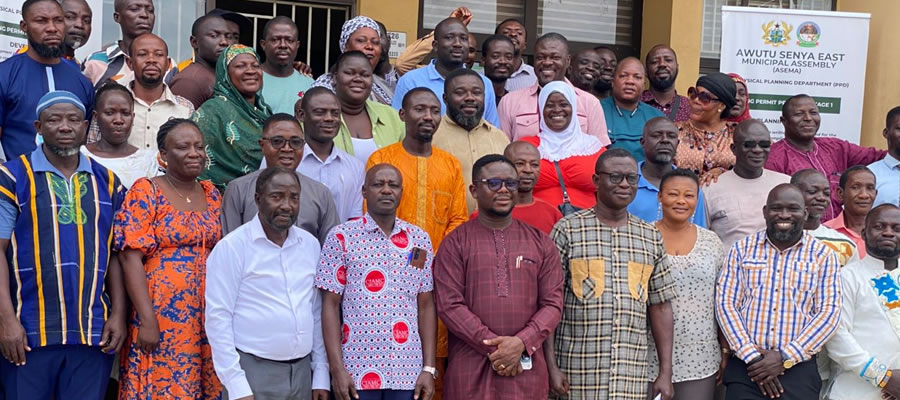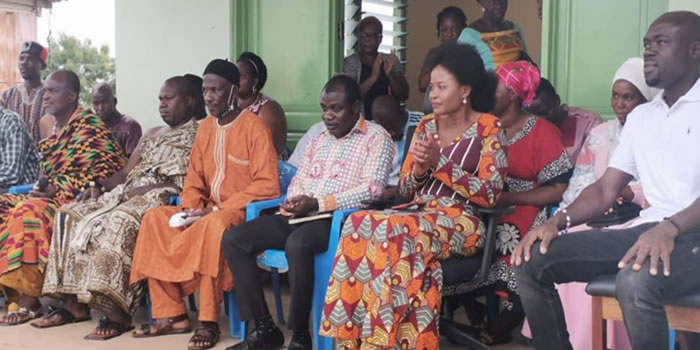

Crop Farming
The Municipality is a hub for agriculture and its related activities. Data from the Department of Agriculture in the District and the 2010 Population Census Report indicates that about 54% of households in the District are engaged in agriculture. The dominant occupation of rural households in the Municipality is agricultural and mainly into subsistence farming and small scale animal rearing.
Generally, 75.8% of households engaged in agricultural activities are into crop farming with 23.6 percent are engaged in livestock rearing. Tree planting and fish farming are undertaken by less than one percent of households in agriculture.
The northern portion of the district is suitable for pineapple and vegetable production. There are large and medium scale farmers who produce pineapple for export. Bawjiase is noted for its cassava cultivation, hence the Ayensu Starch Factory. Cocoa is also cultivated in Bawjiase area and beyond. Prudent Farms is one of the large commercial farms which have about 20 out growers. Other large scale pineapple farmers include Grand mill farms, Jei River Farms and George field farms.
Most of these large Scale farmers use irrigation system powered by pumps along river banks, dams and dug-outs.
The major crops produced can be put under 3 (three) classification:
a) Horticultural crops are pineapple, vegetables (pepper and cabbage) water melons, garden eggs, papaya.
b) Food crops are maize, cassava, yam, plantain, sweet potato.
c) Perennial crops such as cocoa and oil palm and coconut also cultivated.
Table 4: Major Agricultural commodities produced in the District.
Source: ASDA Department of Agric 2016
Agro- processing
I. Cassava Processing:
Besides cassava processing into dough (‘agbelima’) and gari which are sold at Kasoa, Bawjiase and Bontrase markets and also to other adjoining Districts and even to traders from Republic of Togo and Benin, there is the Ayensu Starch Company Limited located at Bawjiase which is earmarked to produce industrial starch for export. There are other two cassava processing facilities at….This initiative has forward and backward linkages; both from the bye-product and for cassava cultivation.
II. Other Small Scale Processing:
There are other products such as sugar cane and palm nuts which are processed, on small scale basis, into local gin (akpeteshie) and palm oil among others. These processors are few in number and their processed products are mostly in small quantities meant for household use and small markets.
III. Pineapple and Citrus Production: The district has enclaves of commercial pineapple farms examples are Jei River San Valley Farms, Prudent, 2K Farms etc. which mainly export raw pineapples. Attempts are being made to process pineapple in the District to add value to the raw materials for local and international markets. A few processing plants are near completion and to take off. The strategic location of the district in relation to Accra and the Tema port gives a comparative advantage for the establishment of these large scale pineapple farms and a processing factory for export and local markets.
IV. Vegetable Cultivation: Large quantities of tomatoes and pepper are produced in the District. Bonsuoko, and Senya are noted for high seasonal tomato and pepper production. However, there is a high post-harvest losses during the season due to lack of storage facilities.
V. Livestock Production: Livestock is also kept in the District. Goats, sheep Cattle, Piggery and Poultry constitute the main livestock enterprise in the district. The district has some poultry farms around the Senya, Bawjiase, Bontrase and Bereku areas. A massive injection of capital is required to enable the sector generate wealth for the immediate population and to provide the employment for the many unemployed youth within the district.
The major livestock /poultry are as indicated in the table below:
Table 5: Livestock and type
Constraint to livestock Enterprise
The following are some of the constraints livestock farmers faced in the Municipality.
• Inadequate quality feed during the dry season
• Poor management practices (ie feeding and health care) resulting in low productivity
• Fewer watering points especially dams and dug out during the dry season for small and large ruminants
• Occasional shortage of feed ingredients for commercial poultry farmers
• Inadequate credit
• Not well developed livestock market
• Disease outbreaks
Fishing
The Municipality is endowed with about 3km stretch of coastal line. The inhabitants around the coastal stretch, the Senya people, are largely involved in fishing and its accompanying activities such as fish mongering among others.
Food Security
Food Security is a situation whereby conscious efforts are made to ensure that food is available all year round at affordable prices in the right quantity and at the right time. In this district, agriculture and its related activities employ over 54% of the population. Also, the horticultural plantation industry especially pineapple and cocoa production, processing and export is a major investment area where major commercial farmers work in.
To ensure food security, the district assembly through MOFA is implementing the under listed set of activities:
• Block farming being implemented and the crop under consideration is maize with farmers being introduced to new technology for increased yield. Government supplies a lot of the inputs.
• Irrigation farming is being encouraged in areas where there are wetlands that can be used as sources of water that purpose. Some farmers around Bawjiase, Bontrase and Offadaa use sprinklers taking water from dugouts.
• Government through MOFA assist farmers with credit facilities to provide small ruminants, its housing as well as the HEIFER Project which brings in improved hybrid cattle for crossing for the various farmer associations.
• The Municipal Assembly is also facilitating the improvement of markets in the district and therefore started the process of expanding markets in Bawjiase and other areas.
Date Created : 10/24/2024 12:00:00 AM











 facebook
facebook
 twitter
twitter
 Youtube
Youtube
 +233 593 831 280
+233 593 831 280 0800 430 430
0800 430 430 GPS: GE-231-4383
GPS: GE-231-4383 info@ghanadistricts.com
info@ghanadistricts.com Box GP1044, Accra, Ghana
Box GP1044, Accra, Ghana